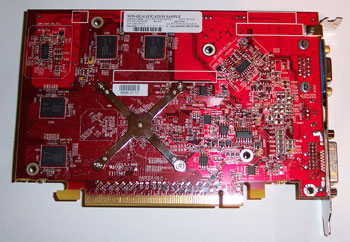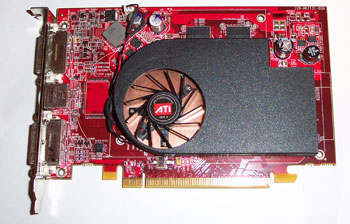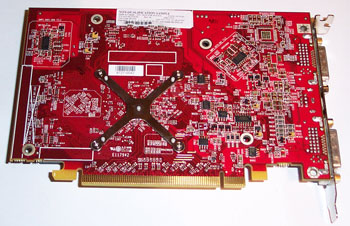Reference Board Examinations
Let's play spot the difference. One's X1300 PRO, one's X1600 XT.The display connectors should give it away for the observant, the X1600 XT sporting a pair of DVI connectors, the primary one of which is dual-link. The X1300 PRO reference board sports dual-link DVI and VGA, instead, both sharing video out capabilities to boot.
The 282g X1600 XT is just over 4 grams heavier than the X1300 PRO, indicating that, despite sharing the same cooler, some board components are different, not least the display connectors. And that's correct, the X1600 XT doing things ever so slightly differently in terms of memory voltage regulation componentry, the other DVI port and DRAM count.
Both boards are PCI Express natively and occupy a 16X physical slot on the latest mainboards.
Theoreticals
Clocks for the reference X1600 XT are 590MHz for GPU and 690MHz (nearly 1.4GHz DDR) for memory. The X1300 PRO comes in at 600MHz GPU and 400MHz (800MHz DDR). Chip configurations dictate the following theoreticals, based on those clock rates.| ATI Radeon X1600 XT | ATI Radeon X1300 PRO | |
|---|---|---|
| Pixel fillrate | 2.36G pixels/sec | 2.40G pixels/sec |
| Texture sampling rate | 9.44G samples/sec | 9.60G samples/sec |
| Z-only fillrate | 4.72G samples/sec | 2.40G samples/sec |
| Vertex transform rate | 737.5M tris/sec | 300.0M tris/sec |
| VP MADD issue rate | 2.95G instr/sec | 1.20G instr/sec |
| FP MADD issue rate | 7.08G instr/sec | 2.40G instr/sec |
| Memory bandwidth | 22.08 GB/sec | 12.80 GB/sec |
Noise
If you buy an X1300 PRO or X1600 XT, make sure it doesn't come with the reference cooler as pictured here. It's X700 PRO/XT-esque in its obnoxiousness, annoying at even the quietest levels the fan is capable of before turning off completely. Which it never does. Infact, the driver revision used for testing would never adjust the X1300 PRO fan speed, leaving it at an ear-splitting 100% the entire time.Thank the AIB partners for almost always replacing the cooler for something passive and therefore silent, or at least nice and easy on the ol' eardrums.
Summary
The shader-happy RV530 shows off its focus on shader rate, fed and watered by ample memory bandwidth that keeps a double Z rate happy to boot. Focus on texture rate, while still of importance, is taking an obvious second seat to math ability in ATI's latest generation of hardware. It smacks RV515 around in pure calculation terms, especially when fragment processing.Let's see if that focus pays off in a round of theoretical testing and real-world performance evaluation using a few of the latest and greatest PC games.













